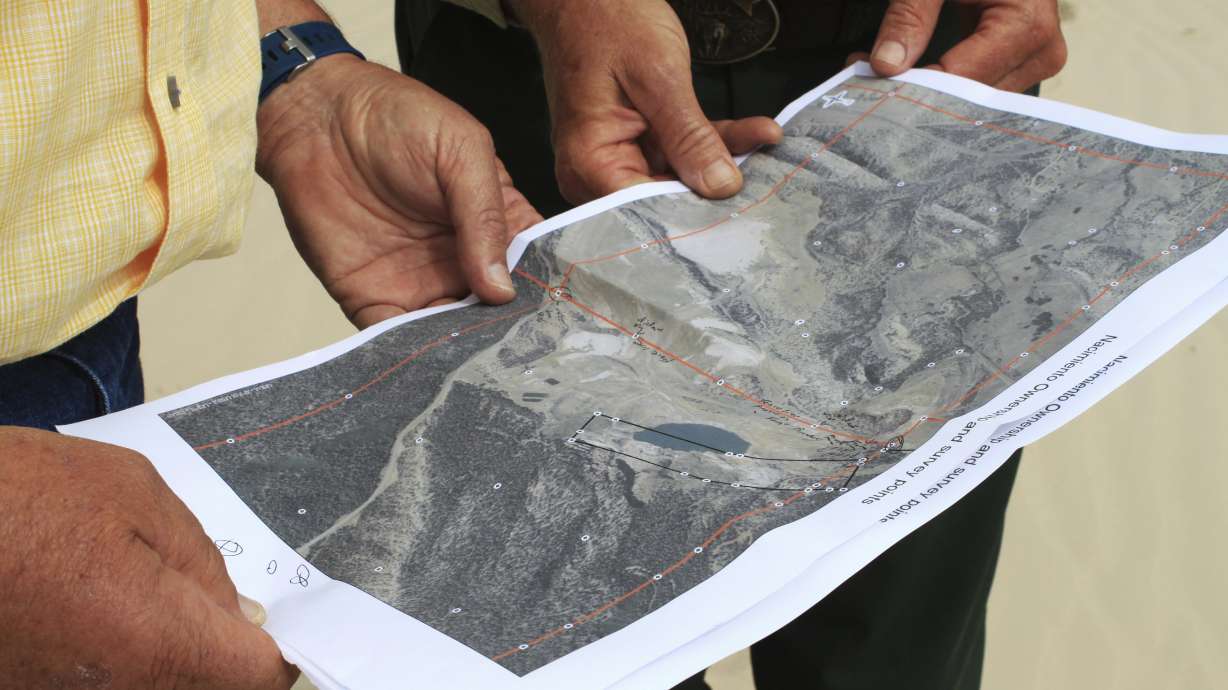Estimated read time: 4-5 minutes
This archived news story is available only for your personal, non-commercial use. Information in the story may be outdated or superseded by additional information. Reading or replaying the story in its archived form does not constitute a republication of the story.
CUBA, N.M. (AP) — For decades, yellow- and white-tinged piles of waste from a defunct copper mine have covered the mountainside at the edge of the quintessential New Mexico village of Cuba — out of sight, out of mind and not nasty enough to warrant the attention of the federal government's Superfund program.
Still, State Land Commissioner Aubrey Dunn says something needs to be done as heavy metals leach from the tainted soil.
"It's not going to go away," Dunn said while standing on the expansive sand dune that has developed over the tailings. "There are two choices: Do nothing and look the other way or start to figure out how to fix it."
Dunn's office has hired a consultant to identify alternatives for cleaning up the tons of waste left behind on the portion covering state trust land. The findings are due next week.
The study also will look at costs. Dunn estimates over $5 million — an expense he said the state should not really be saddled with.
The Nacimiento Mine is among many sites in the West where polluters are long gone and state and local governments have been left holding the bag. As is the case in New Mexico, many sites were mined long before regulations required companies to post bonds for remediation and restoration.
Overall, federal land managers estimate there as many as 500,000 abandoned mines in the U.S. and cleanup efforts are spread between various federal and state agencies as part of broader programs.
Federal agencies alone have informally estimated that they spend around $85 million annually on remediating hardrock mines.
The threats stemming from abandoned mines became real in 2015 when a federal contractor crew breached a pile of debris that was holding back water inside the Gold King Mine in southwestern Colorado. About 3 million gallons spilled, sending a mustard-colored plume of pollution into waterways in Colorado, New Mexico and Utah. Indian lands were also affected.
The U.S. Environmental Protection Agency ended up designating the Gold King and 47 other mining sites in the area a Superfund district. The spill also triggered lawsuits and dozens of damage claims.
The New Mexico Environmental Law Center has been tracking abandoned mines, particularly uranium mines along the Arizona-New Mexico border and copper mines in the southern part of New Mexico. The group contends the issue is under-recognized.
"They're not getting much attention, if any at all. Nevertheless, they're still festering and contaminating resources," attorney Eric Jantz said of the forgotten sites. "In terms of the resource damage that these mines do, I think there's a certain amount of willful ignorance on the part of policymakers."
Dunn said sites such as Nacimiento should serve as an example. "That's why we need to be responsible in what we do," he said.
According to a review of state records, the story of the Nacimiento Mine started in the 1950s when the first mineral lease was secured, even though mining in the area dated back to the 1880s. There also are stories of Spanish conquistadors smelting copper from the surrounding hills centuries before.
Following extensive exploration in the 1960s, mining and milling began at the site in 1971. Production topped about 4,000 tons a day, with the waste rock being dumped to the south as the pit became deeper.
After mining stopped in 1975, another company tried unsuccessfully to dissolve minerals out of the formation using a process known as in-situ leaching. That left behind contaminated groundwater, which the U.S. Forest Service has been working to clean up on its portion of the property.
Initial estimates indicated 25 million gallons would need to be treated. In fact, more than 67 million gallons have been treated since work started in 2011 and officials expect another two to three years of treatment before water quality levels are acceptable, said Larry Gore with the Santa Fe National Forest.
State records show the mine has been on the radar of land managers and environmental regulators for decades, but there are no indications that the early leases required anything more than covering the tailings with soil, reseeding the area and controlling erosion.
In 1992, the state Environment Department issued a notice of violation over groundwater issues and much of the investigations since then have focused on water, not the soil.
Dunn said Nacimiento operations over the years amounted to less than $20,000 for the State Land Office, which uses lease revenues from mining and oil and gas drilling on trust lands to fund public education.
"All we ended up with was damaged land," he said. "At the end of the day, the school children of New Mexico are going to be on the hook for this. That's what's sad about this."
Copyright © The Associated Press. All rights reserved. This material may not be published, broadcast, rewritten or redistributed.








